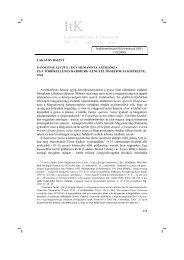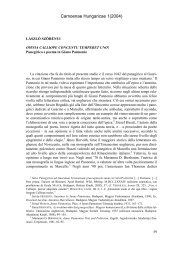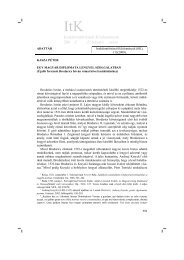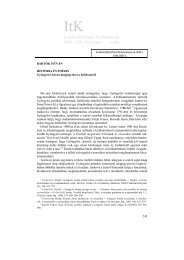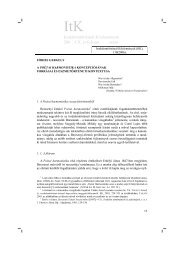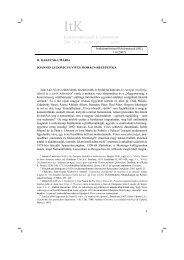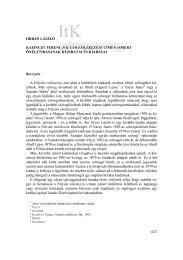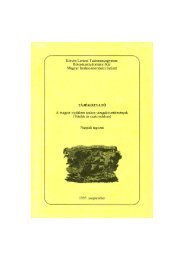Camoenae Hungaricae 3(2006) - Irodalomtörténeti Közlemények
Camoenae Hungaricae 3(2006) - Irodalomtörténeti Közlemények
Camoenae Hungaricae 3(2006) - Irodalomtörténeti Közlemények
You also want an ePaper? Increase the reach of your titles
YUMPU automatically turns print PDFs into web optimized ePapers that Google loves.
<strong>Camoenae</strong> <strong>Hungaricae</strong> 3(<strong>2006</strong>)<br />
region. This latter can be found among the Bologna papers both in Italian and in a<br />
cleaned-up Latin version that was prepared for publication: Primo abbozzo del Compendio<br />
storico dell’Ungaria, per servire d’introduzione al trattato “Acta executionis pacis”<br />
(vol. 117), and Epitome historicum regni Hungariae, sive Prodromus et Introductio ad<br />
“Acta executionis pacis Carlowicensis”, ad Clementem XI. P. M. (vol. 19) respectively.<br />
This brief historical monograph is deserving of a thorough analysis on its own, 95 but<br />
here I will highlight only its most prominent characteristics. First of all, we need to note<br />
that the author intended the text as an apology as well. He emphasised his role both in the<br />
peace treaty negotiations and in the determination of the borders while making it obvious<br />
that besides his expertise, it was his unconditional loyalty to the Emperor which made<br />
him suitable for the task. The parts detailing the vicissitudes of the peace negotiations are<br />
very informative and the descriptions coming from a witness and a participant make it<br />
valuable as a source. The utilisation of antique military history—in this case the boundary<br />
construction techniques of the Roman Legions—in creating the new borders for the<br />
Habsburg empire is revelational. But even more important is the way the dual interpretative<br />
framework works. Marsili, on the one hand, traced the rebellions and aristocratic<br />
conspiracies in Hungary that had always hampered the struggle against the Turks, back to<br />
the Turkish War of 1663–1664, more precisely to the Peace of Vasvár from which the<br />
Hungarians were excluded instead of being consulted. At the same time, he attributed a<br />
special role to Miklós Zrínyi over against the aristocrats conspiring against Vienna. After<br />
devoting a lengthy analysis to his political ambitions and habits, he came to the conclusion<br />
that had Zrínyi lived, he would probably have found a way to pacify his compatriots<br />
and come to a compromise with the court in Vienna. 96 One of the reasons for this apparently<br />
surprising appreciation for the well-known rival of his admired Montecuccoli is that<br />
Marsili probably saw in the Croat Ban an early version of himself, somebody who was<br />
just as unjustly treated by the Court as himself. 97 Apart from personal feelings, the basic<br />
95 The Primo abbozzo / Epitome historicum regni Hungariae, sive Prodromus et Introductio (hereafter:<br />
Prodromus) demonstrates the shift in perspective compared to Marsili’s earlier historical sketches (Memorie e<br />
introduzione, Epitome della ribellione) first pointed out ROZSNYÓI 2002, op. cit., 135–137.<br />
96 “Praeterea si Nicolaus Zrinus diutius superstes fuisset, simultates inter Magnates Hungariae viguissent,<br />
Vienna vero laeta diutius tutam tranquillamque pacem agitavisset.” Prodromus, without pagination. (Marsili<br />
devotes special space to the learnedness of Zrínyi—“Enimvero Nicolaus gerebat alebatque ingentes spiritus<br />
dignos erecta, ac perpolita litteris indole, regiamque dignitatem anhelabat”—and attributes to him certain<br />
ambitions for the throne, but according to him, Zrínyi had designs not on the Hungarian but on the Polish<br />
crown and would surely have prevented his co-conspirators from turning to the Turks for help.)<br />
97 For all his distinction, Zrínyi lost his bid for the Palatineship against Wesselényi who enjoyed the support<br />
of the court in Vienna. Just like Marsili, who never received true recognition for his devoted labours,<br />
perhaps because of the suspicions of his peers (see Autobiografia, 212). The description merits citation:<br />
“Paulo ante […] mortem obiit Nicolaus Zrinus vir et consilij magni, et virtutis, et generis, qui tamen non sine<br />
exulcerato erga Caesaream Aulam animo decesserat, propterea quia se licet bello, paceque clarum, et fortasse<br />
pro nimia virtute et apud exteros favores susceptum, in Regij Palatini officio posthabuisset Francisco Vesseleno,<br />
qui non tam obscuro genere, quam ingenio malo, pravoque adversus eum, a quo acceperat beneficia,<br />
fuit.” Prodromus, without pagination. On the contemporary structure of the Viennese court, its fractions and<br />
137



